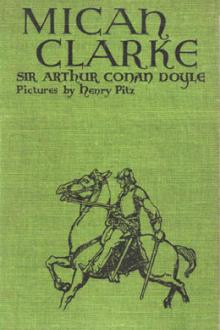Three Thousand Years of Mental Healing, George Barton Cutten [crime books to read TXT] 📗

- Author: George Barton Cutten
- Performer: -
Book online «Three Thousand Years of Mental Healing, George Barton Cutten [crime books to read TXT] 📗». Author George Barton Cutten
While it was not unknown before, the presentation of a piece of gold was first generally introduced in the reign of Henry VII. It probably descended from a practice common in the time of Edward III, whose coin, the rose-noble, is said to have been worn as an amulet to preserve from danger in battle. The angel-noble of Henry VII, valued at ten shillings, appears to have been the coin given; it was in common use and not made especially for this purpose. It had the figure of the Archangel Michael on one side and a ship in full sail on the other. Before hanging it on the patient's neck the monarch always crossed the sore with it. The outlay for gold coins presented to the afflicted on these occasions rose in some years as high as £10,000. So great was the expense that after the reign of Elizabeth the size of the coin was reduced. Touching pieces of the time of Charles II are not rare even now.
In 1684 Surgeon John Browne published a curious work entitled Adenochoiradelogia: or an Anatomick-Chirurgical Treatise on Glandules and Strumæs, or King's Evil Swellings. In this the author traces the gift of healing from our Saviour to the apostles, and thence by a continuous line of Christian kings and governors, and holy men, commencing with Edward the Confessor, whom he regards as the first curer of scrofula by contact or imposition of hands. After referring to his majesty in most flattering terms, he continues concerning "the admirable effects and wonderful events of his royal cure throughout all nations, where not only English, Dutch, Scotch, and Irish have reaped ease and cure, but French, Germans, and all countreyes whatsoever, far and near, have abundantly seen and received the same: and none ever, hitherto, I am certain, mist thereof, unless their little faith and incredulity starved their merits, or they received his gracious hand for curing another disease, which was not really evermore allowed to be cured by him; and as bright evidences hereof, I have presumed to offer that some have immediately upon the very touch been cured; others not so easily quitted from their swellings till the favor of a second repetition thereof. Some also, losing their gold, their diseases have seized them afresh, and no sooner have these obtained a second touch, and new gold, but their diseases have been seen to vanish, as being afraid of his majesties presence; wherein also have been cured many without gold; and this may contradict such who must needs have the king give them gold as well as his touch, supposing one invalid without the gift of both. Others seem also as ready for a second change of gold as a second touch, whereas their first being newly strung upon white riband, may work as well (by their favour). The tying the Almighty to set times and particular days is also another great fault of those who can by no means be brought to believe but at Good Friday and the like seasons this healing faculty is of more vigour and efficacy than at any other time, although performed by the same hand. As to the giving of gold, this only shows his majesties royal well-wishes towards the recovery of those who come thus to be healed."175 He refers to some "Atheists, Sadducees, and ill-conditioned Pharisees" who disbelieved, and he gives the letter of one who went, a complete sceptic, to satisfy his friends, and came away cured and converted.
Browne includes the following case which seems to him conclusive: "A Nonconformist child, in Norfolk, being troubled with scrofulous swellings, the late deceased Sir Thomas Browne, of Norwich, being consulted about the same, his majesty being then at Breda or Bruges, he advised the parents of the child to have it carried over to the king (his own method being used ineffectively); the father seemed very strange at this advice, and utterly denied it, saying the touch of the king was of no greater efficacy than any other man's. The mother of the child, adhering to the doctor's advice, studied all imaginable means to have it over, and at last prevailed with her husband to let it change the air for three weeks or a month; this being granted, the friends of the child that went with it, unknown to the father, carried it to Breda, where the king touched it, and she returned home perfectly healed. The child being come to its father's house, and he finding so great an alteration, inquires how his daughter arrived at this health. The friends thereof assured him, that if he would not be angry with them, they would relate the whole truth; they, having his promise for the same, assured him they had the child to be touched at Breda, whereby they apparently let him see the great benefit his child received thereby. Hereupon the father became so amazed that he threw off his Nonconformity, and expressed his thanks in this manner: 'Farewell to all dissenters, and to all nonconformists; if God can put so much virtue into the king's hand as to heal my child, I'll serve that God and that king so long as I live, with all thankfulness.'"176 It is unfortunate that we have a change of air and food to consider in this case, else we might have a good example of a real miracle.
Friday was usually set apart in this reign as the regular day for healing, but, in addition to this, special portions of the church year were reserved for the exercise of this gift. Very careful examinations were made by the surgeons, and those who were found to be suffering from the evil were presented with a ticket by the surgeon which entitled them to receive the healing touch of the king. If the king's touch were really efficacious, one might think that the disease should have been wholly exterminated during this reign, so great were the number touched. On the contrary, the deaths were more numerous, and on account of the neglect of medical and surgical means it spread very widely.
James II, it is said by Dr. Heylin, also wrought cures upon babes in their mothers' arms, and the fame of these cures was so great that the year before James was dethroned, a pauper of Portsmouth, New Hampshire, petitioned the general assembly to enable him to make the voyage to England to be healed by the royal touch. In one of his progresses James touched eight hundred persons in Chester Cathedral.
William III evidently thought of the matter as a superstition, and on one occasion he touched a patient, saying to him, "God give you better health and more sense"; notwithstanding the incredulity of the sovereign, Whiston assures us that the person was healed. With honest good sense, however, William refused to exercise the power which most of his subjects undoubtedly thought he possessed, and many protests were made, and much proof was adduced concerning "the balsamic virtues of the royal hand." This refusal to continue the practice of touching brought upon him the charge of cruelty from the parents of scrofulous children, while bigots lifted up their hands and eyes in holy horror at his impiety.
Dr. Samuel Johnson was one of the last persons to receive the imposition of royal hands; when a boy of four and a half years, he was touched by Queen Anne, together with about two hundred others, on March 30, 1712. In his case at least the touch was inefficacious, for he was subject to scrofula all his life. Boswell says:177 "His mother, yielding to the superstitious notion, which, it is wonderful to think, prevailed so long in this country, as to the virtue of the royal touch; a notion which our kings encouraged, and to which a man of such inquiry and such judgment as Carte could give credit, carried him to London, where he was actually touched by Queen Anne. Mrs. Johnson, indeed, as Mr. Hector informed me, acted by the advice of the celebrated Sir John Floyer, then a physician in Litchfield." At this time few persons but Jacobites believed in king's touch as a miracle. Dr. Daniel Turner, though, relates that several cases of scrofula which had been unsuccessfully treated by himself and Dr. Charles Bernard, sergeant-surgeon to her majesty, yielded afterwards to the efficacy of the queen's touch.
During the reign of Anne the sceptics outnumbered the believers and at her death the practice was discontinued. Among the unbelievers was the above-mentioned Dr. Charles Bernard, an account of whose conversion is given by Oldmixon as follows: "Yesterday the queen was graciously pleased to touch for the King's evil some particular persons in private; and three weeks after, December 19, yesterday, about twelve at noon her majesty was pleased to touch, at St. James', about twenty persons afflicted with the King's evil. The more ludicrous sort of skeptics, in this case, asked why it was not called the queen's evil, as the chief court of justice was called the Queen's Bench. But Charles Bernard, the surgeon who had made this touching the subject of his raillery all his lifetime till he became body surgeon at court, and found it a good perquisite, solved all difficulties by telling his companions with a fleer 'Really one could not have thought it, if one had not seen it.' A friend of mine heard him say it, and knew well his opinion of it."178
In 1745 there was an attempted revival of the practice when Prince Charles Edward exercised this prerogative of royalty.
Henry VII was the first monarch to establish a particular ceremony to be observed at the healings. He probably derived this from an old form of exorcism used for the dispossessing of evil spirits. This was altered at various times but may still be found in the prayer-book of the reign of Queen Anne. Indeed, it was not until some time after the accession of George I that the University of Oxford ceased to reprint the office of healing, together with the Liturgy.
The routes to be travelled by royal personages and the days on which the miracle was to be wrought were fixed at sittings of the Privy Council, and the clergy of all the parish churches of the realm were solemnly notified. They, in turn, informed the people, and the sufferers along the way had many days in which to cherish the expectation of healing, in itself so beneficial. The ceremony was conducted with great solemnity and pomp. It has been vividly described by Macaulay as follows: "When the appointed time came, several divines in full canonicals stood round the canopy of state. The surgeon of the royal household introduced the sick. A passage of Mark 16. was read. When the words 'They shall lay their hands on the sick and they shall recover,' had been pronounced, there was a pause and one of the sick was brought to the king. His Majesty stroked the ulcers and swellings, and hung round the patient's neck a white ribbon to which was fastened a gold coin. The other sufferers were led up in succession; and as each was touched the chaplain repeated the incantation, 'They shall lay their hands on the sick and they shall recover.' Then came the epistle, prayers, antiphonies, and a benediction."
Evelyn, in his Diary, gives us the form employed by Charles II in July, 1660, as follows: "His Majestie first began to touch for evil according to costume, thus—His majestie sitting under his state in the Banquetting House, the Chirurgeons cause the sick to be brought or led up to the throne, where





Comments (0)